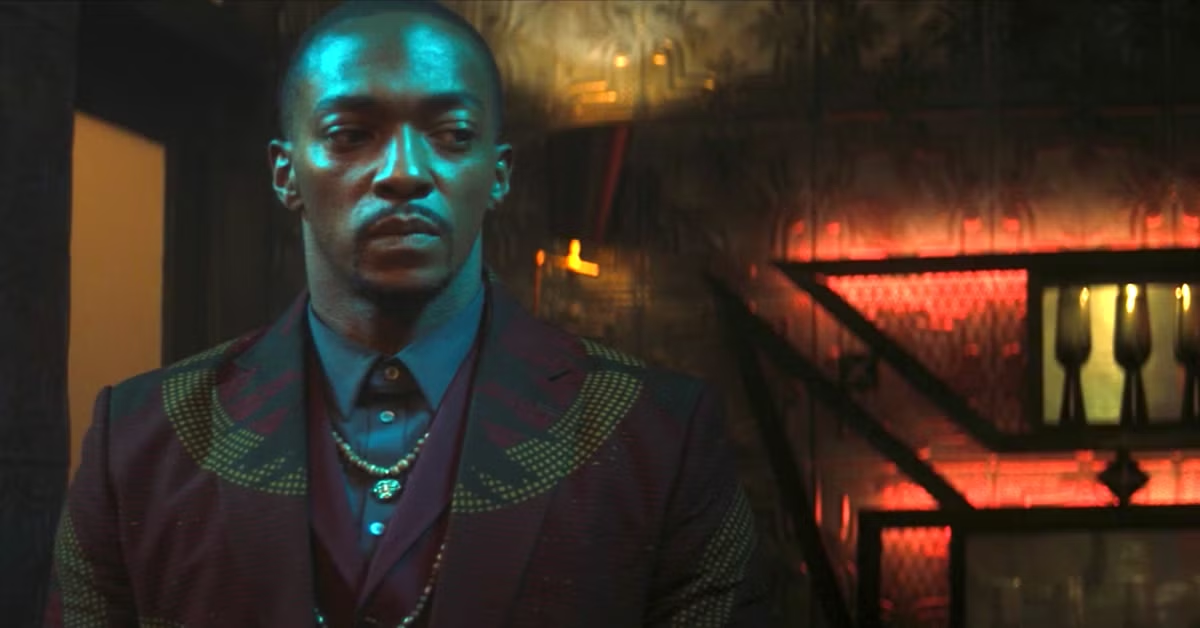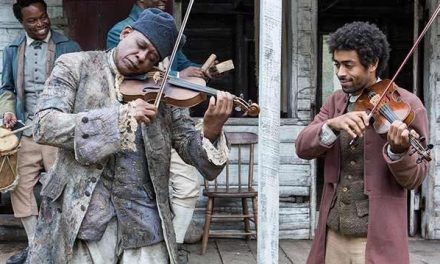Throughout the year 2021, Disney+ released a series of…well, series, which took place in and followed various characters of the wider hyperdiegesis conventionally referred to as the Marvel Cinematic Universe (MCU). While responses to the various streaming series have been mixed, they do seem to allow for a wider and deeper exploration of characters and settings. In that context I have chosen to focus on The Falcon and the Winter Soldier (2021, Disney+; hereafter FaWS), particularly a section of a scene in a bar in episode three.
For those unfamiliar with the series, FaWS follows Sam Wilson (Anthony Mackie) and Bucky Barnes (Sebastian Stan) as they follow a group of newly created supersoldiers. The series engages a great deal with disempowered groups, particularly Black Americans, as well as engaging with migration. I discuss the latter in a forthcoming conference paper; here instead I would focus upon a section of the six-episode series in which Sam and Bucky, along with semi-reluctant ally Baron Zemo (Daniel Brühl), travel to a fictitious country called ‘Madripoor.’ Though the exact location is unclear, it contains elements from multiple Southeast Asian countries, particularly Singapore (e.g., its seemingly small size and large wealth disparity).[i] One of these elements is cuisine, specifically alcohol containing the heart of a cobra, and it is in this element which the main issue I will discuss arises.

The fictional maritime southeast Asian city of Madripoor
Snake wine, of various types, is primarily associated with Vietnamese cuisine. Somaweera and Somaweera (2010) note the prevalence of the industry, to the point where they argue that sustainable use programmes are required to avoid overconsumption; this is despite the fact that there are risks of coagulopathy (at the very least) from its consumption (Jeong and Byeong 2016).[ii] Snake consumption is also strongly linked to masculinity, presumably due to an association between the shape of a phallus and the shape of a snake. Nyman (2003), writing of A Cook’s Tour (2000-2022 Food Network), states that
The mastery of the Other is then attainable to other travellers should they share [presenter Bourdain’s] adventurous masculinity and desire. Thus, the representation of the cuisine is tightly located in the context of race and gender and cannot be separated from the general process of Othering also evident in these narratives of travel amidst non-Western cultures (Nyman 2003: 101).
This is relevant to my argument in two ways. The scene in which the snake wine occurs involves several problematic elements. Sam, Zemo and Bucky are going to a bar to meet a criminal; though Zemo and Bucky are (more or less) themselves, Sam is undercover. The following exchange occurs before they enter:
Sam: We have to fix this. I’m the only one who looks like a pimp.’
Zemo: ‘Only an American would assume a fashion-forward Black man looks like a pimp. You look exactly like the man you’re supposed to be playing. The sophisticated, charming African rake named Conrad Mack, aka the Smiling Tiger.’

Sam (e.g. The Falcon) dressed as Conrad Mack, aka the Smiling Tiger
While the point about potential differences in perspective between the African-American Sam and a man from Africa is apt (though poorly studied), the fact that the character is termed ‘African’ is itself problematic in two ways. The first is that it treats Africa as a country, rather than a continent of over fifty separate countries and hundreds of disparate cultures. Sam’s costuming incorporates elements from several parts of sub-Saharan Africa, though does not seem localised to any particular region; this increases the elision of nuance and distinctiveness of the many cultures of the continent. Secondly, the character of Mack in the comics is a feral, non-speaking criminal who is half-Cambodian and not of African descent (Atkinson 2021).[iii] Thus relocating the character to ‘Africa’ also erases or elides the character’s Southeast Asianness and his connection to/critique of the Vietnam War.[iv] Given that Madripoor is a mix of Southeast Asian countries in particular and the scene I am discussing relates to Vietnamese cuisine, this elision (arguably erasure) is inherently problematic.
Once the characters arrive at the bar and are greeted, Sam is given ‘his’ usual preferred beverage of cobra wine. While snake meat is eaten in some regions of West Africa (D’Cruze et al 2020) and Central Africa (Hardi et al 2017), I have found no evidence of its use in wine or other alcohol, implying that this was not some slightly ham-fisted attempt at cultural representation but was, in fact, a reference to Vietnamese cuisine being included in a Madripoor bar. Within the scene, drinking the wine is characterised as Sam’s strength (i.e., masculinity) being challenged[v] and it is also played for comedy, further rendering the idea of drinking snake wine as not only ‘gross’– itself connected to masculinity, cf Nash 2011– but also as a mastery, arguably consumption, of non-American/Non-Western Others. While remembering that Sam was the presumptive and later, accepted, new ‘Captain America’ who is engaging in this Othering display can perhaps be read as showing a flawed metonym for a flawed state, it seems not to have been intentionally subversive but rather a play on the ‘weird foods’ masculinity trope which is present in many Western travelogues (Nyman 2003).
This brings up an additional issue with FaWS, particularly regarding the segment spent in Madripoor. While Sokovia and Wakanda are largely developed fictitious countries within the wider MCU hyperdiegesis and are used for different types of sociocultural critique, Madripoor is essentially reduced to a backdrop for the American (and Sokovian-played-by-German) characters, much as Gray’s (2020) description of the various places contestants in The Amazing Race (CBS 2000-present) travel. Despite a main character, Sharon Carter, (Emily VanCamp) residing in and having become a major criminal figure in Madripoor, there is no real critique of the extreme wealth inequality, or the seemingly powerful positions acquired by non-local people or anything relating to sociocultural power. This is in direct contrast to how disempowered people in the US and, arguably, Europe, as well as wider geopolitical power and its (ab)use are intensively nuanced and debated over the course of the series. While it is certainly possible that additional critique or exploration of Madripoor was precluded by a limited runtime of six episodes and/or that the US-majority production team were unwilling or felt themselves unable to engage in such critique, it does seem to represent a missed opportunity for an even wider portrayal of Earth and its many cultures.
Thus far, to the best of my knowledge, Madripoor has not been shown in other MCU texts, though it has appeared in the comics. Given the attention to and critique from the MCU’s other fictitious countries and the explicit critiques of power imbalances in FaWS, it seems as though the reduction of Madripoor and its constituent countries and cultures to a reductive, Othered backdrop does those countries and cultures an almost-certainly unintentional disservice. The idea of ‘normal,’ regarding cuisine or any other social norm, is a discursive construct inextricably bound to power. In this instance, FaWS used its sociocultural and geopolitical power to diminish and Other, rather than to empower, to unnecessarily reinforce American masculinity through attempted humour. And that, I think, does give us all food for thought.
Dr Melissa Beattie is a recovering Classicist who was awarded a PhD in Theatre, Film and TV Studies from Aberystwyth University where she studied Torchwood and national identity through fan/audience research as well as textual analysis. She has published and presented several papers relating to transnational television, audience research and/or national identity. She is currently an independent scholar. She is under contract with Lexington/Bloomsbury for an academic book on fictitious countries and Palgrave for a book on Canadian crime dramas. She has previously worked at universities in the US, Korea, Pakistan, Armenia, Ethiopia, Cambodia and Morocco. She can be contacted at tritogeneia@aol.com.
References
Atkinson J (2021) Marvel’s Smiling Tiger explained: Who is Conrad Mack (Powers & Comics Origin). Screen Rant (2 April). https://screenrant.com/falcon-winter-soldier-smiling-tiger-conrad-mack-explained/ (accessed 29 July 2025).
D’Cruze N Assou D Coulthard E Norrey J Megson D Macdonald DW Harrington LA Ronfot D Segniagbeto GH and Auliya M (2020) Snake oil and pangolin scales: insights into wild animal use at “Marché des Fétiches” traditional medicine market, Togo. Nature Conservation 39: 45–71
Gray J (2020) The Amazing Race: Global Othering. In E Thompson and J Mittell (eds) How to Watch Television, 2nd ed. New York: NYU Press, 165–173.
Hardi R Babocsay G Tappe D Sulyok M Bodó I and Rósza L (2017) Armillifer-infected snakes sold at Congolese bushmeat markets represent an emerging zoonotic threat. EcoHealth 14, 743–749
Jeong M M Byeong J C (2016) Severe coagulopathy after ingestion of “Snake Wine”. The Journal of Emergency Medicine 50(6): 848-851.
Nash K (2011). Documentary-for-the-other: relationships, ethics and (observational) documentary. Journal of Mass Media Ethics 26(3): 224–239.
Nyman J (2003) Fancy some cobra? Exploring Vietnamese cuisine in contemporary culinary travelogues. Journeys 4(1): 84-102.
Somaweera R and Somaweera N (2010) Serpents in jars: the snake wine industry in Vietnam. Journal of Threatened Taxa 2(11): 1251-1260.
Footnotes
[i] Singapore also being called Singapura in Malay.
[ii] Though most cobras have neurotoxic or cytotoxic venom, vipers and other snakes have venom that is haemolytic. The only case study available does not specify the type of snake used in the wine production, though lack of regulation in the wine’s production may have placed a role in the health impacts. Cooking allows for snake meat to be safely eaten, however, and it is a relatively common source of protein in many cuisines. I confess I have not yet tried it, though I very much want to do so!
[iii] Tigers are native to Asia, particularly South and Southeast Asia. They are not present in continental Africa.
[iv] I have discussed the US’ ‘Secret War’ elsewhere.
[v] In a later sequence Sam notes that he cannot run in the Cuban heels his undercover character wears, further playing with gender.





